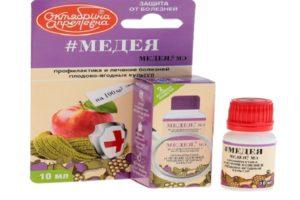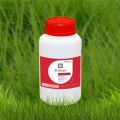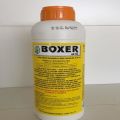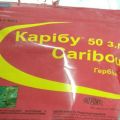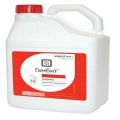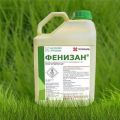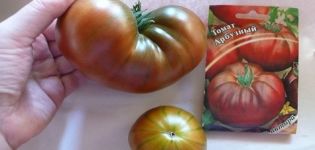Instructions for the use of the herbicide Glifogold, mechanism of action and consumption rates
Weed vegetation does not allow obtaining a full-fledged harvest, interferes with the vegetation of agricultural crops. The use of herbicides is the chemical weeding of crops. Preparations of continuous action are able to clear the soil of all types of weeds, prepare fields for sowing. Let's consider the possibilities of the herbicide Glifogold - properties, instructions for use, consumption rates.
Content
- 1 Composition, purpose and form of release of the drug Glifogold
- 2 Advantages in comparison with analogues
- 3 Mechanism of action
- 4 Consumption rates for different plants
- 5 How to prepare a working solution?
- 6 Instructions for using the ready-mixed mixture
- 7 Safety in use
- 8 Herbicide toxicity
- 9 Is it compatible with other drugs?
- 10 Terms and conditions of storage
- 11 Similar means
Composition, purpose and release form of the drug Glifogold
The herbicide belongs to the class of organophosphorus substances, its active substance is glyphosate at a concentration of 360 grams per liter. Available in the form of an aqueous solution.
The manufacturer recommends using the herbicide in the post-emergence period, at the beginning of vegetative processes in weeds. The active ingredient has a contact and systemic effect on sensitive weeds.
Glyfogold is used as a continuous and selective drug in the following cases:
- for cleaning orchards and vineyards;
- to eliminate weeds in the fields of grain, potatoes, corn, sunflower;
- processing of vapors, fields before sowing;
- clearing weeds from alienated territories along roadsides, near industrial facilities;
- processing of parks and recreation areas.
The activity of the herbicide applies to the following types of vegetation:
- annual and perennial dicotyledonous and cereal weeds;
- hard-to-remove malignant species - thistle and bindweed, other species;
- shrubs and trees - willow, alder, elm, acacia;
- a wide range of herbaceous vegetation.
The herbicide is poured into 20 liter plastic cans.
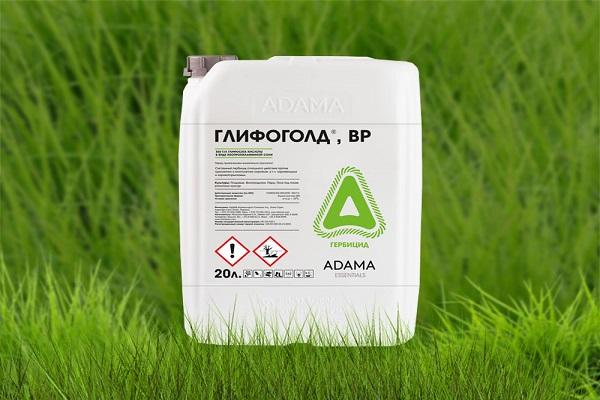
Advantages in comparison with analogues
The undoubted advantages of Glyfohold are:
- comprehensive action on sensitive objects - from the ground part to the roots, destruction of overgrown rhizomes of weeds;
- complete and rapid decomposition in the soil, which does not limit crop rotation, allows for use before sowing in pairs;
- non-toxic to protected crops;
- has a pronounced contact effect, is quickly absorbed by the green part of the weeds, which allows you to choose a lower rate when spraying.
The drug has a wide spectrum of herbicidal action, the regulations for use have been worked out and tested.
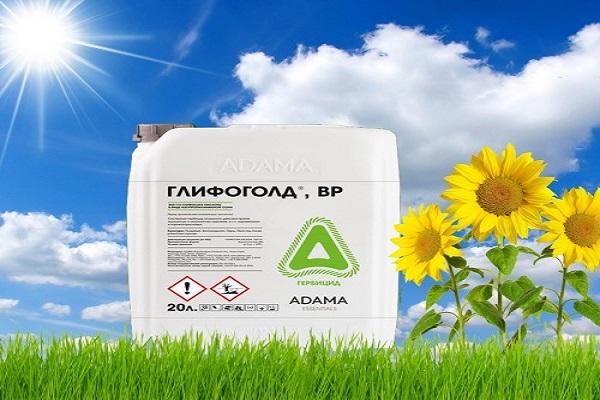
Mechanism of action
Glyphosate is absorbed by the surface of the weeds, enters the conductive system and spreads to all tissues, reaches the root.
The herbicide stops the production of amino acids, which leads to inhibition of vegetation, and then to the death of the plant. The foliage loses its turgor, turns yellow, points of growth die off, the plants bend, dry out.
Glyphosate that gets into the soil is not dangerous for plants, since it is not absorbed by the roots.
Important: when using a herbicide, it should be remembered that this substance is of continuous action - it destroys many types of vegetation.
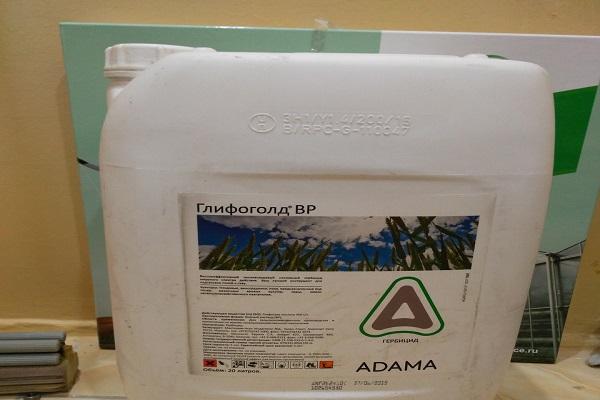
Consumption rates for different plants
When choosing consumption rates, it is important to take into account the features of clogging, the types of destroyed plants and protected crops:
| Protected objects | Glyfogold application rate in liters per hectare | Weeds |
| Fruit gardens, vineyards | 2-4 | Annuals |
| Orchards | 4-8 | Perennial |
| Preparation of fields for planting cereals, vegetables, industrial, oilseeds, herbs | 2-4
4-6 6-8 | Annual cereals and dicotyledons Perennial Hard-to-remove species - pig, thistle |
| Camping fields - couples | 2-4
4-6 6-8 | Annual cereals and dicotyledons Perennial Hard-to-remove species - pig, thistle |
| Use outside farmland | 3-6
6-8 | Herbaceous, except resistant All herbaceous |
For processing 1 hectare, use from 100 to 200 liters of the working mixture.

How to prepare a working solution?
The working mixture is prepared at special sites. Pour half the rate of water into the sprayer tank, add Glyfogold while the hydro mixer is running. After thorough mixing, the remaining water is introduced.
The weed control solution must be used within a few hours; the working mixture is not stored.
Instructions for using the ready-mixed mixture
Regulations for the use of the herbicide on different crops:
- In the spring and summer, weed vegetation is sprayed in gardens, vineyards, observing the protection of cultural plantings.
- Fields of cereals, vegetables, oilseeds are cultivated after harvest, when the weeds are in the growing season.
- Couples pollinate when the weeds begin to grow actively. The best result is achieved at the stage 2-4 sheets.
- Parks, exclusion zones along highways are sprayed during the period of vegetation development. Gathering berries, herbs, mushrooms on the territory is prohibited.
One-time processing is allowed per season. It is carried out in calm, cool weather with no precipitation.
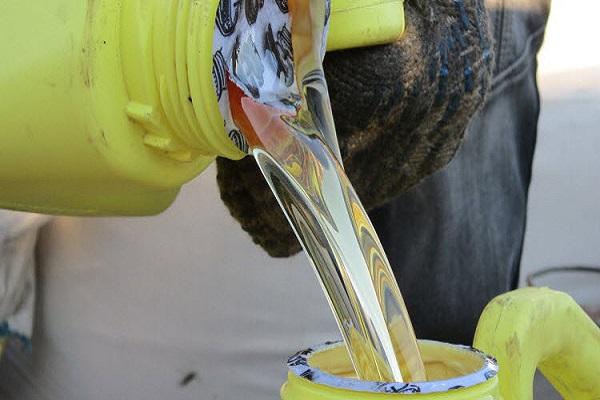
Safety in use
When working with Glyfogold - preparing a mixture, spraying a solution - use the usual precautions:
- all manipulations are carried out in a protective suit with a mask and goggles;
- do not allow contact with the herbicide of animals, bees;
- the rest of the mixture is disposed of in the prescribed manner.
It is allowed to go out into the fields 3-7 days after pollination from weeds.

Herbicide toxicity
The drug belongs to the group of low-hazard agents - class 3 for humans and bees. Glyfogold quickly decomposes in the soil, after application, you can plant any crops.
Is it compatible with other drugs?
There is a positive experience of the combined use of Glyfogold with drugs:
- Atrazine;
- 2,4-D;
- Dicamba.
Before spraying, it is required to check the prepared mixture on the treated culture.
Terms and conditions of storage
The stated warranty period is 5 years in an unopened original container. Storage is allowed in special warehouses for chemicals at temperatures from -1 ° to +35 °.
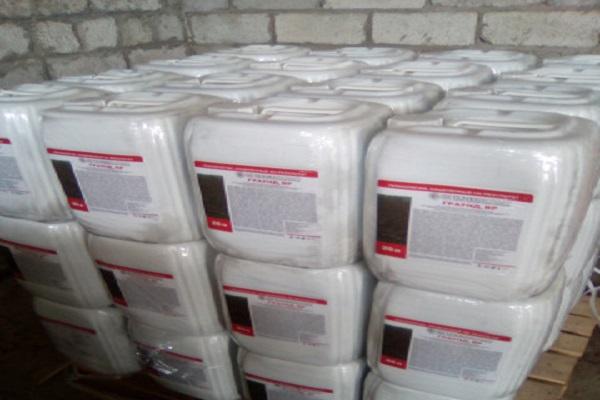
Similar means
Many herbicides are produced on the basis of glyphosate under different trade names. All of them can be considered analogs (in brackets, the glyphosate content in grams):
- Agrokiller (500);
- Bestseller (687);
- Gleebel (360);
- Glyphos (360);
- Fighter (360);
- Kernel (480);
- Pylaround (360);
- Octopus (360);
- Swift (687).
Herbicides are available in the form of an aqueous solution or granules. When choosing a drug, you should read the instructions, which indicate the features of use against weeds.
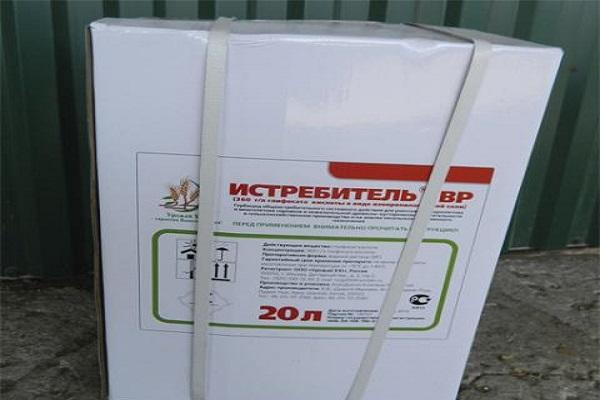
Continuous herbicides are successfully used to clear weed-overgrown areas, to prepare fields for sowing. Despite its insignificant toxicity and rapid decomposition in soil, Glyfogold should be used with caution, not exceeding the recommended rates and within the specified time frame. In this case, the herbicide will show all the declared properties - it will destroy weeds and will not harm the environment.
